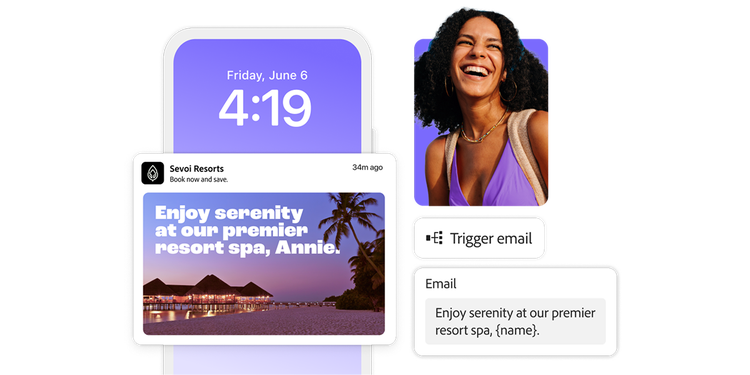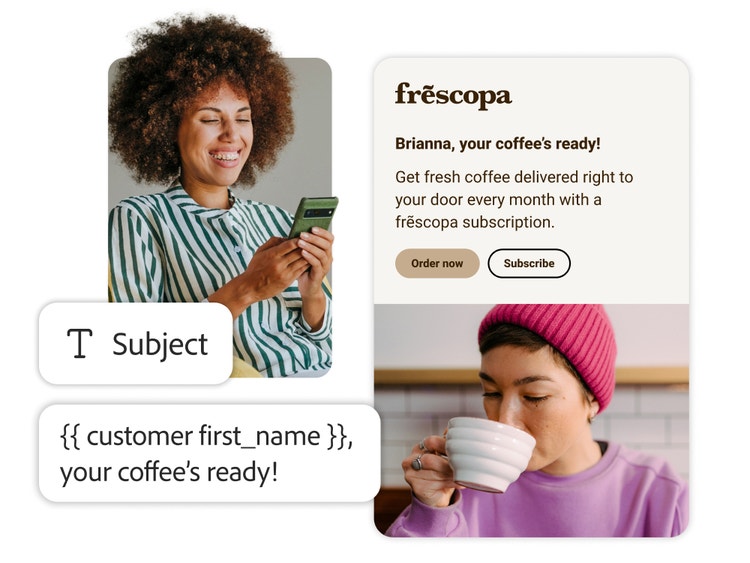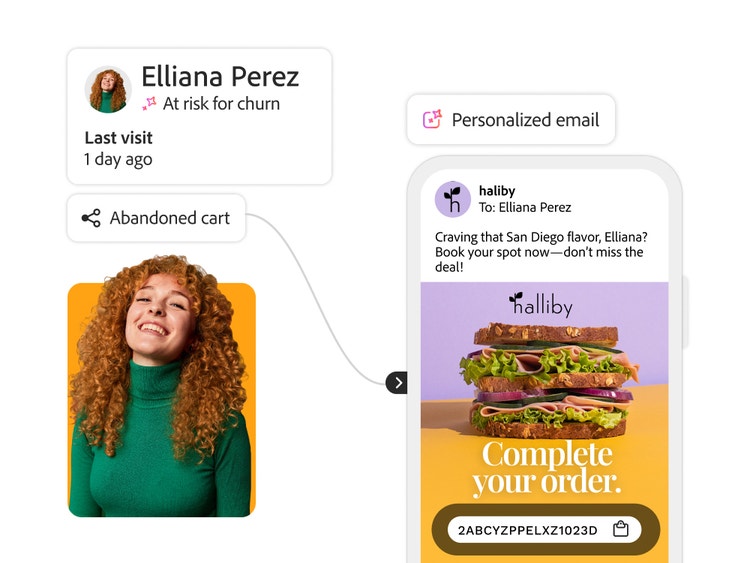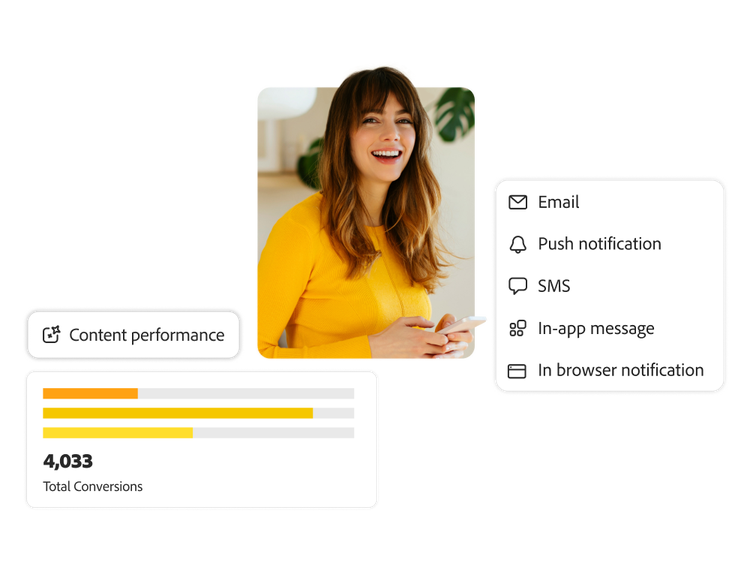
of executives believe GenAI will bring major change to email marketing.

Email marketers today aren’t short on goals. They’re short on time, control, and clarity. In conversations with expert marketers, one theme keeps surfacing: The day-to-day work of email marketing is harder than it should be.
Emails still take too long to create. Deliverability rules are shifting under their feet. AI is everywhere, but practical use cases are hard to pin down. And while the industry pushes toward real-time journeys and 1:1 personalization, most teams are still navigating siloed systems, fragmented workflows, and campaign calendars that remain essential but disconnected from the rest of the customer experience.
This guide surfaces six of the most pressing challenges email marketers are facing right now. For each, we’ve included tactical solutions and tools that can help teams move faster, collaborate better, and evolve toward more personalized, omnichannel engagement — with email at the center.

Creating a single email shouldn't take weeks, but for many teams, it still does. Alt text According to a survey by Litmus, 51% of marketers say it takes two or more weeks to get just one email out the door. Multiply that timeline across campaign calendars, personalization goals, and layers of review — it's easy to see how things start to stall.
One major culprit is the traditional, linear workflow. Marketers often hand off to data teams for segmentation, then wait on creative teams for content, followed by a long approval process. Each step adds friction and delays, leaving marketers with little control over the pace or quality of execution.
That challenge is often compounded by fragmented systems. Many teams are working across multiple Email Service Providers (ESPs) and martech platforms, with data and content scattered across tools that don’t talk to each other. Reporting is inconsistent, integrations are clunky, and decision-making becomes a manual, IT-dependent process. The result is slower production and reduced agility, especially when marketers need to act fast.
That’s why more teams are shifting to a marketer-led model. Instead of being dependent on handoffs or navigating disconnected platforms, marketers are placing themselves at the center of the workflow with access to the tools and data they need to move faster and more independently.

Here’s how teams can start to make that shift:
1. Put curated profile data within reach
Marketers need the ability to explore real-time customer data and define segments tied to specific business goals. Applications like Adobe Journey Optimizer allow teams to pull in profile data and personalize messages directly, without waiting for support from data analysts and technical teams.
2. Use content fragments to scale re-use
Marketers and design teams can build a library of modular, on-brand fragments that can be mixed and matched across campaigns. Parameterized fragments let you customize the dynamic parts while keeping the base content consistent — making it faster to personalize at scale.
3. Integrate content tools directly into the authoring experience
Product capabilities should be directly accessible to marketers in their workflows across applications, including those like Adobe Express, Adobe GenStudio for Performance Marketing, Adobe Experience Manager, and no-code templating tools like Stensul or dynamic personalization tools like Movable Ink. Adobe Journey Optimizer supports product integrations that streamline content creation without switching applications.
4. Consolidate fragmented tools into a single workflow
Marketers want to plan and execute email campaigns, lifecycle journeys, and transactional messages from one platform — with orchestration, content creation, experimentation, decisioning, and measurement all in one place. Journey Optimizer is purpose-built in this way to reduce reliance on multiple systems. It helps you spend more time creating and delivering, and less time navigating technical complexity.
5. Automate and streamline approvals
Needless back-and-forth to get final approval slows down even the most efficient teams. A well-designed solution sets clear stages of review — such as base content signoff and final deployment approval — and automates what you can do to keep work moving without unnecessary delays.
Even the most beautifully crafted email can’t drive results if it never makes it into the inbox. Today, deliverability is getting harder to manage.
Inbox providers — especially Microsoft, Apple, Google, and Yahoo (often grouped as MAGY) — are rolling out new deliverability requirements that go well beyond the basics. It’s not just about sender reputation anymore. Marketers now need to manage increasingly strict rules around spam thresholds, authenticated domains, matching ‘from’ addresses, and clearly visible unsubscribe options.

The stakes are high. Some brands are seeing dips in inbox placement. Others worry about getting flagged at the domain level, which could affect their entire sending program. For companies using multiple ESPs or martech platforms, this complexity is magnified. It’s not uncommon for teams to juggle dozens of IP addresses, parent and subdomains, and inconsistent sender configurations across platforms.
And it’s not just deliverability rules that are changing — it's how inbox providers present emails too. Apple’s mail application now uses AI to generate previews of email content, often rewriting or misrepresenting what’s actually inside the message. For image-heavy designs or emails with embedded tagging code, summaries can be misleading or out of sync with the intended message. As a result, some marketers are adjusting their structure to prioritize plain-text content or restructuring code to influence how AI interprets the message.
Here’s how to get ahead of deliverability disruption and build a more resilient sending strategy:
1. Audit where your emails come from
Start by mapping out all platforms and applications that send emails on behalf of your brand. That includes internal tools, marketing platforms, and even third-party vendors. Identify your IPs, subdomains, and senders. Many teams uncover far more complexity than expected. By centralizing sending through a single platform like Journey Optimizer, you can help consolidate oversight across campaigns, lifecycle programs, and transactional messages.
2. Understand the makeup of your email audience
MAGY providers each have different thresholds and preferences, so it’s important to know your deliverability mix. Once you understand your audience breakdown, outline governance policies that align to platform-specific requirements. Involve cross-functional teams — especially legal, IT, and marketing operations — to help you track changes and stay compliant.
3. Incorporate IP warming, spam scoring, and structured content strategies
Solutions that include built-in IP warming tools that send emails in progressively larger waves can build trust with inbox providers. As you author emails in an application like Journey Optimizer, your messages are scored using tools like SpamAssassin, which provide real-time feedback to help reduce the risk of being flagged. For Apple and other inbox summaries, research how content is being interpreted and consider adapting the structure, tags, and hierarchy to better align with AI-generated previews.
4. Strengthen administrative controls and get expert support
Administrators should have the ability to configure Domain-based Message Authentication, Reporting, and Conformance (DMARC), header settings, unsubscribe handling, ‘from’ addresses, and data governance based on industry requirements. This is especially critical in regulated industries. Adobe also provides deliverability services that can offer proactive guidance, support, and monitoring as inbox rules and AI-driven presentation logic continue to evolve.

of executives believe GenAI will bring major change to email marketing.

say they’ve aligned their AI roadmap with broader business goals.

say that ensuring quality and trust in AI output remains a top challenge.
Here’s how email marketers can start small, build confidence, and scale AI the right way:
1. Start with send-time optimization
This is one of the fastest, minimal risk ways to bring AI into your workflow. The capabilities in Journey Optimizer lets marketers define time windows and goals, while AI finds the optimal send moment for each recipient. You stay in full control of the content and audience, while AI helps improve performance behind the scenes.
2. Use AI Assistant in Adobe Journey Optimizer to generate content — starting small
Load an existing email and use AI Assistant for content generation to create subject line variations based on different tone goals. You can preview and test those options before sending anything live. Once you’re comfortable, expand to include body copy or imagery, and upload brand guidelines to ensure everything stays consistent with your voice and brand identity.
3. Ask conversational questions to unlock product and audience knowledge
AI Assistant isn’t just a writing tool — it can help you explore campaign performance, audience attributes, or platform capabilities in a more intuitive, conversational way. This reduces the time spent digging through documentation and helps you discover new ways to personalize and optimize.
4. Build towards an AI-augmented marketing system, with guardrails
As your AI skills and comfort level grow, you can start exploring more advanced applications such as AI-generated content paired with next-best experience decisioning, AI-driven journey selection, and AI insights linked to experimentation. The key is to be selective. Make sure the solution you adopt is enterprise-ready, with strong controls for data governance, brand safety, and human approval. You should always feel in control and be in the driver’s seat.

Triggered journeys and real-time engagement are getting a lot of attention — and for good reason. But for most email marketers, the campaign calendar is still the backbone of how they operate.
According to the Litmus survey, only 44% of marketers say they use lifecycle emails to activate, engage, and retain customers, while sending more automated and triggered messages was ranked as the top priority for the year ahead. The takeaway? Journeys are gaining ground, but campaigns aren’t going anywhere. They still drive volume, ROI, and brand storytelling.
The challenge is that campaigns and journeys often live in separate systems, owned by different teams with different goals. That disconnect can lead to inconsistent messaging and a fractured customer experience. Customers don’t know — or care — whether a message came from a campaign or a journey. They just expect relevant, consistent communication from your brand — at all times.

Here’s how marketers can bring campaigns and journeys together in a more cohesive, customer-centric way:
1. Keep the campaign calendar, but expand your view
The journey calendar view in Adobe Journey Optimizer allows marketers to see scheduled, in-flight, and complete activations across all channels and types in one place. This unified timeline helps teams manage cadence, avoid conflicts, and spot content gaps during key seasons or high-volume periods.
2. Flex between campaigns and journeys across the lifecycle
In key moments like seasonal acquisition, campaigns may take the lead. As customers engage and convert, real-time journeys become more relevant. Journey Optimizer gives marketers the ability to toggle between these approaches based on context — allowing them to inform and strengthen each other.
3. Embrace multi-step, high-impact campaigns
Major campaigns still play a critical role in telling your brand story and driving key moments. Campaign orchestration capabilities in Journey Optimizer are designed to support sophisticated workflows with multiple steps, ‘pre-send’ audience insights, and segmentation across product, location, or event dimensions. This gives marketers more control and visibility while maintaining creative scale.

While scheduled campaigns work well for some stages of the customer lifecycle, real-time engagement often works better for other stages. Deliver nimbler, more relevant communications by intelligently choosing either approach.

The promise of dynamic, personalized content is exciting — and elusive. According to Litmus, while 80% of marketers believe personalization improves email performance, only 32% are actually using dynamic content to deliver it. This gap highlights a critical challenge — modular personalization sounds great in theory, but it’s tough to execute in practice.
Most brands are experimenting with dynamic content driven by API feeds and modular design systems, but real-world complexities add friction fast. With every customer seeing a different variant, it becomes difficult to pinpoint what’s working. Instead of measuring performance by audience segment, marketers now face the harder task of measuring the impact of each content combination.

Use intelligent decisioning to identify the next best experience for each customer based on their preferences and profiles as well as your priorities.
Here’s how marketers can bring order, insight, and scalability to modular personalization:
1. Centralize decisioning management
Leading brands are creating centralized libraries of dynamic content, offers, and components — organized by rules, collections, and priority levels. Journey Optimizer allows marketers to deploy from these libraries in a way that’s scalable, consistent, and easy to govern across teams.
2. Set rules first, then let AI personalize
AI shouldn't replace your judgment — it should scale it. Start by defining clear rules for eligibility, offer prioritization, and content constraints. Then, let AI dynamically select and deploy the right combinations based on your business goals. You stay in the driver’s seat while AI helps with optimization and execution.
3. Lean into decisioning insights
Rather than just tracking performance by audience, marketers are now reviewing engagement by selection strategy: What content was shown? Why? How did it perform? Dedicated decisioning reports in Journey Optimizer show which content combinations and logic models are driving top performance.
4. Use content analytics to refine what’s working
The next wave of insights will go deeper than clicks. New Adobe capabilities, called Content Analytics in Journey Optimizer, called Content Analytics, help marketers understand which images, styles, colors, or even logo placements are most effective across dynamic combinations. It’s not just which content wins, it’s why.
Most marketing teams still plan by channel: What emails will we send? What’s going out over SMS? What push notifications are queued up? But your customers don’t think by channel. They experience your brand as one unified entity — and they expect the messages they receive to reflect that.
Unfortunately, many companies are still operating in silos. Each team manages their own strategy, tools, and cadence, with little cross-channel coordination. The result? Overlapping messages, inconsistent experiences, and missed opportunities to prioritize the right touchpoints.
It’s a widespread issue. Customers receive 139 messages from brands each week and engage across an average of 9.1 channels. Yet few companies can answer basic questions like: How often are we contacting our customers overall? And which messages matter most?

In the customer-centric approach, organizations break down channel silos for a more consistent and engaging experience.
Here’s how brands can break down silos and improve cross-channel coordination:
1. Start with the customer, not the channel
Work backward from the experience you want the customer to have. What are the key moments? What are the right messages? Then determine which channels support that journey best — instead of planning each in isolation.
2. Map real customer experiences across channels
Select a few recent customers and audit everything they receive across email, SMS, app, and web. Look for redundancies, timing conflicts, or missed prioritization logic. These audits can uncover surprising misalignments and help teams build shared understanding.
3. Use frequency management and conflict resolution tools
Journey Optimizer helps identify when audiences are receiving too many messages and where experiences are overlapping. You can set frequency caps, apply business rules, and use prioritization scoring to ensure the right message wins.
4. Tap into intelligent journey optimization
Brands are looking to apply AI to guide each customer down the right path — minimizing full-file sends and focusing outreach on what will drive actual results like engagement, conversions, or purchases. By using Journey Agent coming soon to Journey Optimizer, you can achieve lower volume and higher relevance, without channel chaos.
Email marketing is evolving fast in the AI era — but the challenges aren’t going away. From long authoring cycles to cross-channel chaos, the pressure on email marketers has never been higher. But, so is the opportunity.
The good news? You don’t have to solve everything overnight. Across these six challenges, one theme emerges — momentum starts with small, strategic shifts. Whether it’s centralizing data, testing AI-powered variants, or consolidating workflows, there are clear ways to move forward without blowing up what’s already working.
The path to omnichannel, customer-centric engagement doesn’t require perfection. It requires progress — and the confidence to take that next step. With the right tools and a mindset focused on experimentation and iteration, email marketers can lead the way in building smarter, faster, more connected experiences.
Adobe Journey Optimizer helps brands deliver personalized, omnichannel campaigns and real-time journeys from a single platform. Built on real-time data and powered by AI, it’s designed to help marketers move faster, work smarter, and engage customers more effectively — anywhere they are.
Discover how Adobe Journey Optimizer can help you modernize your email marketing program.

